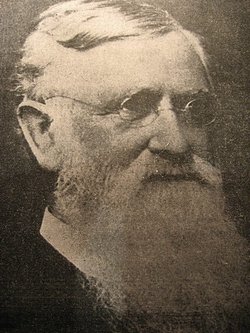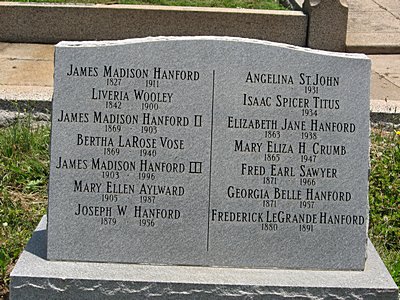He was the paymaster for the Southern Pacific Railroad for 39 years.
This account of his life was written by a grandson,
James Madison Hanford the 3rd.
My grandfather, the man for whom Hanford was named, James Madison Hanford, was born at "Dunk Hill," Walton, New York, December 21, 1827.
When he was 22, he traveled from New York by ship to Colon, Panama. From Colon the trip was overland to Panama City where he re-embarked on another steamer for San Francisco. He made his way to Volcano, California to join his brother Samuel.
After many adventures, including owning a hardware store and a gold mine, involvement with paramilitary groups during the Gold Rush, practicing as Justice of the Peace and teaching school in Volcano — on August 4, 1869 he joined the Central Pacific Railroad as Special Assistant to the President. The Central Pacific later became the Southern Pacific and my grandfather became Paymaster.
From the early 1860's to the late 1880's, the railroad was growing rapidly. Workers were scattered over a vast area and with paper money discounted up to 40%, and wages were paid in gold and silver coins. A specially equipped Pay Car was used to distribute wages to employees. It was a remodeled Pullman car with a kitchen, dining room, sleeping quarters, washroom, and the Paymaster's office. At one end of the office was a partition made of 1/4" boiler plate with a small sliding window through which the employee received his money. The window weighed 90 pounds and could be dropped quickly in the event of an attempted robbery. There was also an iron slide, controlled by a treadle, which could automatically close the cash till which held quantities of 5, 10, and 20 dollar gold pieces. Two sawed off shotguns, four repeating rifles, and two "six-shooters" completed the car's equipment.
In the 1870's, with only one pay car, it took two months to pay all employees. In 1888 three cars were outfitted, and the practice of paying monthly wages was instituted. The cars started from San Francisco and were stocked with enough money to pay all employees along the way. They would have silver piled in every corner of the car, through the center aisle into an empty berth. There was so much gold they couldn't get it all in the safe, and it had to be stacked along the wall. The pay cars were heavily guarded, their schedules kept secret and they did not run at night. Remarkably, they were never robbed.
As a tribute to my Grandfather's honesty as Paymaster, the President of the Southern Pacific gave "Major" Hanford the opportunity to pick a town site on the Goshen-Alcalde branch when it was being built. The Southern Pacific named the station "Hanford." On January 17, 1877, the town was placed on the map by the sale of 68 business lots fronting on the railroad [which had come through] the previous October. This property sold for $11,422.50. The first [business] house was built the following March by druggist, J. T. Baker. He was burned out three times and finally rebuilt using brick.
My grandfather retired from the Southern Pacific in 1908 after 39 years with the railroad. He passed away at his home in Oakland, in 1911.
My grandfather was always very proud of the "town" of Hanford, and would be truly amazed if he could see it now.
He was the paymaster for the Southern Pacific Railroad for 39 years.
This account of his life was written by a grandson,
James Madison Hanford the 3rd.
My grandfather, the man for whom Hanford was named, James Madison Hanford, was born at "Dunk Hill," Walton, New York, December 21, 1827.
When he was 22, he traveled from New York by ship to Colon, Panama. From Colon the trip was overland to Panama City where he re-embarked on another steamer for San Francisco. He made his way to Volcano, California to join his brother Samuel.
After many adventures, including owning a hardware store and a gold mine, involvement with paramilitary groups during the Gold Rush, practicing as Justice of the Peace and teaching school in Volcano — on August 4, 1869 he joined the Central Pacific Railroad as Special Assistant to the President. The Central Pacific later became the Southern Pacific and my grandfather became Paymaster.
From the early 1860's to the late 1880's, the railroad was growing rapidly. Workers were scattered over a vast area and with paper money discounted up to 40%, and wages were paid in gold and silver coins. A specially equipped Pay Car was used to distribute wages to employees. It was a remodeled Pullman car with a kitchen, dining room, sleeping quarters, washroom, and the Paymaster's office. At one end of the office was a partition made of 1/4" boiler plate with a small sliding window through which the employee received his money. The window weighed 90 pounds and could be dropped quickly in the event of an attempted robbery. There was also an iron slide, controlled by a treadle, which could automatically close the cash till which held quantities of 5, 10, and 20 dollar gold pieces. Two sawed off shotguns, four repeating rifles, and two "six-shooters" completed the car's equipment.
In the 1870's, with only one pay car, it took two months to pay all employees. In 1888 three cars were outfitted, and the practice of paying monthly wages was instituted. The cars started from San Francisco and were stocked with enough money to pay all employees along the way. They would have silver piled in every corner of the car, through the center aisle into an empty berth. There was so much gold they couldn't get it all in the safe, and it had to be stacked along the wall. The pay cars were heavily guarded, their schedules kept secret and they did not run at night. Remarkably, they were never robbed.
As a tribute to my Grandfather's honesty as Paymaster, the President of the Southern Pacific gave "Major" Hanford the opportunity to pick a town site on the Goshen-Alcalde branch when it was being built. The Southern Pacific named the station "Hanford." On January 17, 1877, the town was placed on the map by the sale of 68 business lots fronting on the railroad [which had come through] the previous October. This property sold for $11,422.50. The first [business] house was built the following March by druggist, J. T. Baker. He was burned out three times and finally rebuilt using brick.
My grandfather retired from the Southern Pacific in 1908 after 39 years with the railroad. He passed away at his home in Oakland, in 1911.
My grandfather was always very proud of the "town" of Hanford, and would be truly amazed if he could see it now.










